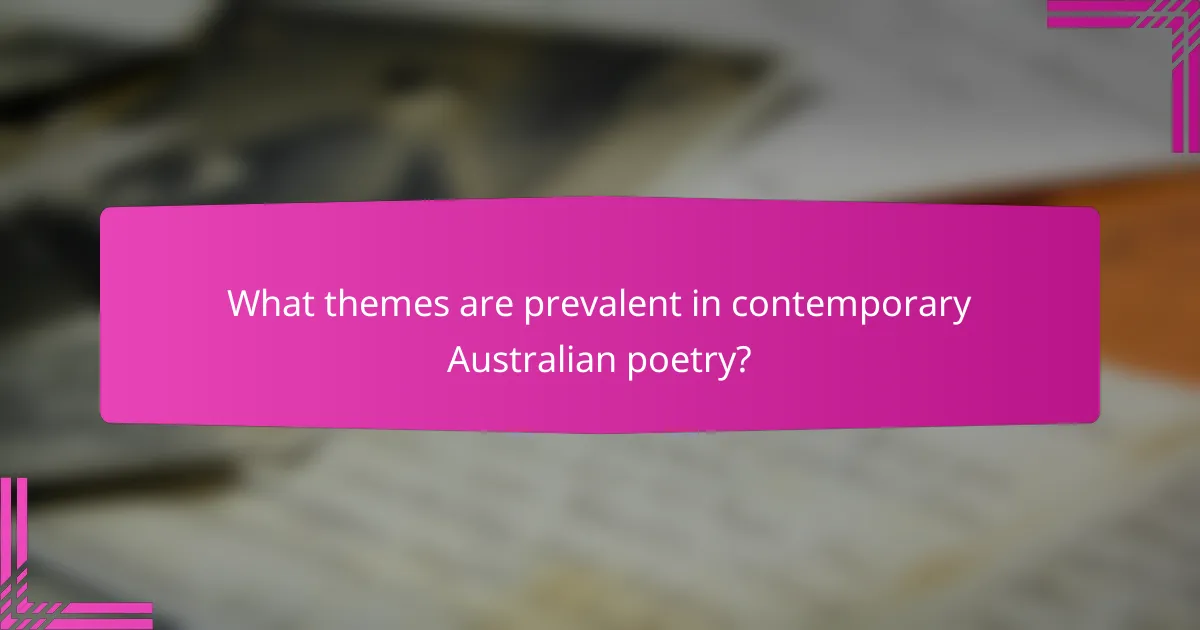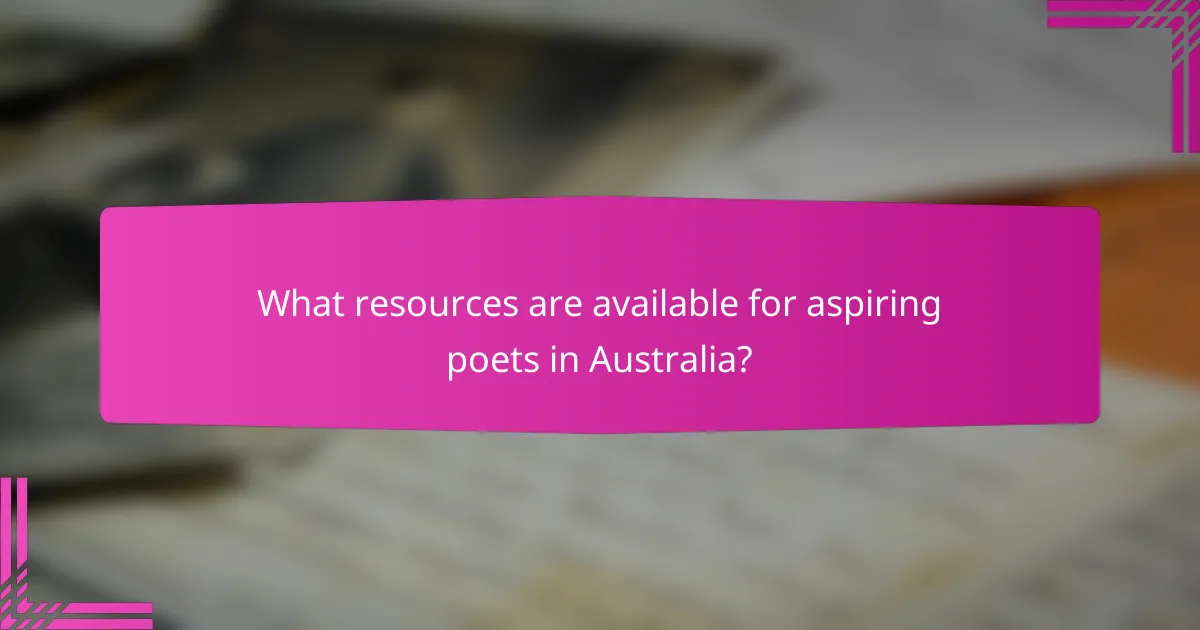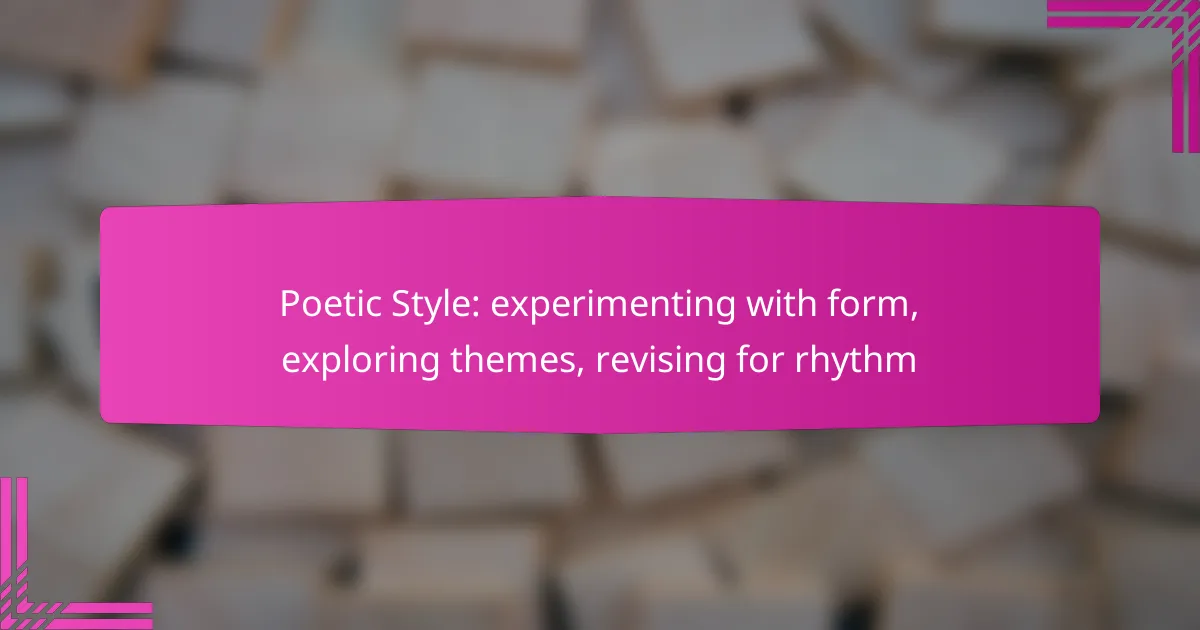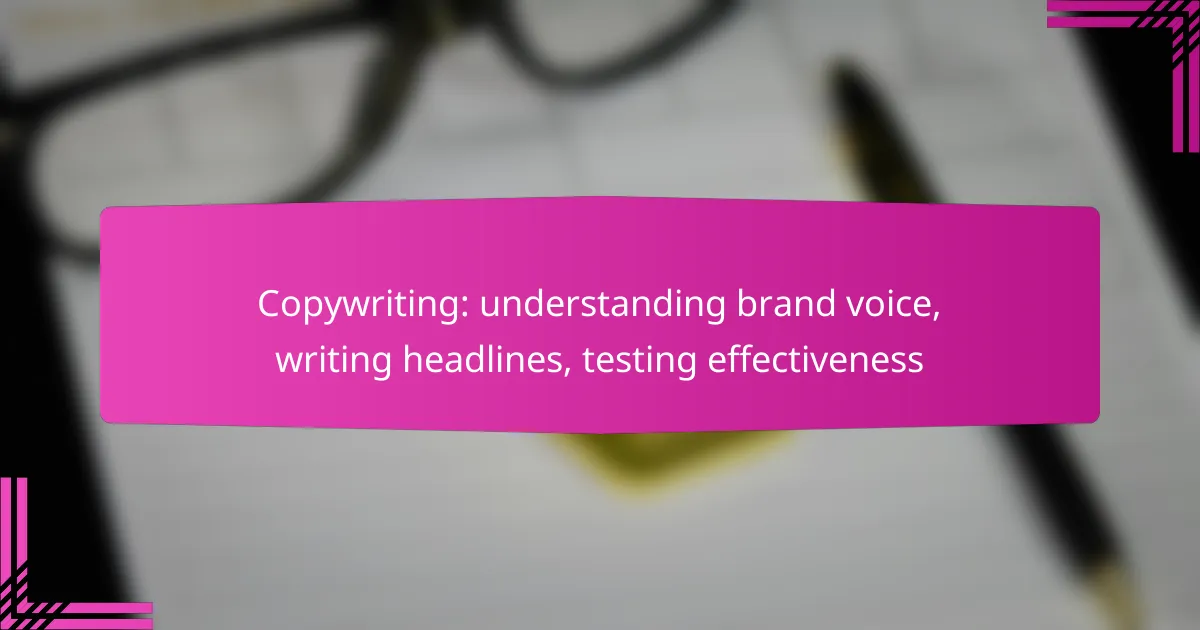Poetic form serves as a vital catalyst for creativity, allowing poets to experiment and innovate within structured frameworks. By delving into diverse themes such as identity, environmental issues, and social justice, contemporary Australian poetry captures the complexities of modern life. Revising for rhythm enhances the emotional resonance of a poem, inviting poets to refine their work through careful attention to meter, line breaks, and auditory flow.

How can poetic form enhance creativity in Australia?
Poetic form can significantly enhance creativity in Australia by providing a framework that encourages experimentation and innovation. By exploring various structures, poets can discover new ways to express themes and emotions, ultimately enriching their work.
Experimenting with free verse
Free verse allows poets to break away from traditional structures, fostering creativity through unrestricted expression. In Australia, this form can reflect the diverse landscapes and cultures, enabling poets to capture unique experiences without the constraints of rhyme or meter.
When experimenting with free verse, consider varying line lengths and rhythms to create a natural flow. Use imagery and sensory details to evoke emotions, making the poem resonate with readers. Avoid overthinking structure; let the content guide the form.
Using structured forms like sonnets
Structured forms, such as sonnets, provide a disciplined approach that can sharpen a poet’s skills. In Australia, sonnets can be adapted to explore local themes, such as nature, identity, and social issues, while adhering to a specific rhyme scheme and meter.
To effectively use a sonnet, focus on a central theme or argument, developing it over the 14 lines. Pay attention to the volta, or turn, which introduces a shift in perspective. This structure can enhance the emotional impact of the poem, making it more compelling.
Incorporating visual poetry
Visual poetry combines text and imagery, creating a unique artistic experience that engages both the eye and the mind. In Australia, this form can reflect the vibrant landscapes and cultural diversity, allowing poets to express ideas in innovative ways.
When incorporating visual elements, consider how the layout of words can enhance meaning. Experiment with fonts, colors, and shapes to create a visual narrative that complements the text. Be mindful of readability; the visual aspect should enhance, not obscure, the poem’s message.

What themes are prevalent in contemporary Australian poetry?
Contemporary Australian poetry often explores themes of identity, environmental concerns, and social justice. These themes reflect the diverse experiences and challenges faced by Australians today, providing a rich landscape for poetic expression.
Identity and multiculturalism
Identity and multiculturalism are central themes in Australian poetry, as poets frequently examine their personal and collective identities within a diverse society. This exploration often includes reflections on heritage, race, and the impact of colonization.
For instance, many poets draw from their cultural backgrounds to create works that resonate with both their own experiences and those of others. This can include the use of Indigenous languages or references to cultural practices, enriching the poetic landscape.
Environmental concerns
Environmental concerns are increasingly prominent in Australian poetry, reflecting the urgent issues related to climate change and ecological degradation. Poets often highlight the beauty of the Australian landscape while simultaneously addressing the threats it faces.
Works may include vivid imagery of natural settings alongside stark warnings about environmental destruction. This duality encourages readers to appreciate nature while recognizing the need for conservation and action.
Social justice issues
Social justice issues are a vital theme in contemporary Australian poetry, with many poets addressing topics such as inequality, racism, and human rights. These works often serve as a call to action, urging readers to reflect on societal injustices and advocate for change.
Poets may use personal narratives or historical references to illustrate the impact of these issues on individuals and communities. This approach not only raises awareness but also fosters empathy and understanding among readers.

How to revise poetry for better rhythm?
To revise poetry for better rhythm, focus on the poem’s meter and flow, ensuring that the beats align with the intended emotional impact. This involves analyzing the structure, experimenting with line breaks, and reading the poem aloud to identify areas for improvement.
Identifying meter and beat
Identifying the meter and beat of your poem is crucial for establishing its rhythm. Meter refers to the pattern of stressed and unstressed syllables, while the beat is the underlying pulse that drives the poem forward. Common meters include iambic pentameter and trochaic tetrameter, each creating distinct rhythmic effects.
To analyze your poem’s meter, scan each line for syllable patterns. Mark the stressed (/) and unstressed (u) syllables to visualize the rhythm. This exercise can reveal inconsistencies or opportunities for variation that enhance the overall flow.
Utilizing enjambment effectively
Enjambment is the continuation of a sentence or phrase beyond the end of a line, which can create tension and propel the reader forward. Using enjambment effectively allows for a more natural speech rhythm and can emphasize particular words or ideas. Consider where a line break can enhance meaning or emotional impact.
When revising, look for lines that can be split to create enjambment. Aim for a balance; too much can disrupt the flow, while too little may lead to a monotonous rhythm. Experiment with different placements to see how they affect the poem’s pacing.
Reading aloud for flow
Reading your poem aloud is one of the most effective ways to assess its rhythm and flow. This practice helps you hear the natural cadence of the language and identify awkward phrases or uneven pacing. Pay attention to how the words sound together and whether they evoke the intended emotions.
As you read, take note of any lines that feel clunky or disrupt the overall rhythm. Consider revising these lines for smoother transitions or more impactful word choices. Listening to the poem can reveal insights that silent reading might miss, ensuring a more polished final piece.

What are the key elements of poetic style?
Key elements of poetic style include the use of imagery, sound devices, and emotional tone. These components work together to create a unique voice and enhance the overall impact of the poem.
Imagery and symbolism
Imagery involves using descriptive language that appeals to the senses, allowing readers to visualize scenes and emotions. Symbolism adds depth by using objects or actions to represent larger ideas, enhancing the poem’s meaning.
For example, a rose might symbolize love, while a storm could represent turmoil. When crafting imagery and symbolism, consider how specific details can evoke feelings and connect to broader themes.
Sound devices and alliteration
Sound devices, such as rhyme, meter, and alliteration, contribute to the musical quality of poetry. Alliteration, the repetition of consonant sounds at the beginning of words, can create rhythm and enhance memorability.
For instance, phrases like “whispering winds” or “sudden silence” draw attention and create a pleasing auditory effect. When using sound devices, aim for a balance that supports the poem’s mood without overwhelming the content.
Emotion and tone
Emotion in poetry conveys the feelings and attitudes of the speaker, while tone reflects the overall mood. Together, they shape how readers interpret the poem’s message and connect with its themes.
To effectively convey emotion and tone, consider word choice, sentence structure, and punctuation. For example, short, abrupt sentences can create tension, while longer, flowing lines may evoke calmness. Experiment with these elements to find the right balance for your poem.

What resources are available for aspiring poets in Australia?
Aspiring poets in Australia can access a variety of resources to enhance their craft, including workshops, online platforms, and publishing opportunities. These resources provide essential support for developing skills, sharing work, and connecting with the literary community.
Workshops and writing groups
Workshops and writing groups are excellent ways for poets to refine their skills and receive feedback. Many local libraries, community centers, and universities offer regular workshops that cater to different skill levels. Joining a writing group can also foster a sense of community and accountability.
Consider participating in events like the Australian Poetry Festival, which often features workshops led by established poets. These sessions can range from a few hours to several days, providing intensive learning experiences.
Online platforms like Poetry Australia
Online platforms such as Poetry Australia serve as valuable resources for poets looking to share their work and connect with others. These platforms often feature forums, writing prompts, and opportunities for publication, making them accessible to poets across the country.
Additionally, social media groups focused on poetry can provide instant feedback and support. Engaging with these online communities can help poets stay motivated and inspired, especially in remote areas where in-person resources may be limited.
Publishing opportunities in local journals
Local journals are a key avenue for poets to publish their work and gain recognition. Many Australian literary journals actively seek submissions from emerging poets, providing a platform to showcase their writing to a broader audience.
Researching journals that align with your poetic style is crucial. Some well-known journals include Meanjin, Southerly, and Overland. Be sure to review their submission guidelines carefully, as they often have specific themes or formats they prefer.

How does poetic experimentation influence reader engagement?
Poetic experimentation enhances reader engagement by introducing innovative forms and structures that captivate attention. This approach encourages deeper exploration of themes and emotions, making the reading experience more dynamic and memorable.
Creating unique reading experiences
Experimenting with poetic form can lead to distinctive reading experiences that stand out from traditional poetry. Techniques such as varied line lengths, unconventional stanza arrangements, and the use of visual elements can draw readers in and challenge their expectations. For example, a poem that incorporates visual layout may require readers to navigate the text in a non-linear fashion, enhancing their interaction with the work.
Additionally, incorporating multimedia elements, such as audio or video, can further enrich the experience. This blending of formats can engage different senses, making the poem more immersive and appealing.
Encouraging emotional connections
Innovative poetic styles can evoke strong emotional responses by presenting familiar themes in unexpected ways. By breaking traditional structures, poets can create tension and surprise, which often resonates with readers on a personal level. For instance, a poem that juxtaposes stark imagery with soft language can create a powerful emotional contrast that lingers in the reader’s mind.
Moreover, experimenting with rhythm and sound can amplify emotional impact. The use of varied meter and rhyme schemes can enhance the musicality of a poem, making it more relatable and memorable.
Fostering diverse interpretations
Poetic experimentation invites readers to engage with the text in multiple ways, fostering diverse interpretations. When poets play with ambiguity and open-endedness, they allow readers to bring their own experiences and perspectives into the reading process. This can lead to rich discussions and varied understandings of the same piece.
For example, a poem that employs metaphor and symbolism may be interpreted differently depending on the reader’s background or emotional state. This multiplicity of meanings encourages deeper analysis and appreciation of the work, ultimately enhancing reader engagement.



